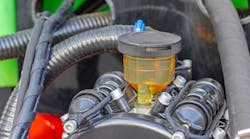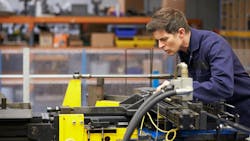9 Ways Fluid Power Tech Needs to Improve for Industrial Applications
The National Fluid Power Association (NFPA) is in the process of developing a new Technology Roadmap focused on industrial, or in-plant, applications (read the sidebar at the end of this article to learn more). As part of this process, NFPA has released a new report outlining the capability improvements required of hydraulics and pneumatics to meet the performance needs of various industrial machinery.
Per NFPA, capability improvements describe the ways in which fluid power systems must improve in order to continue being a technology of choice in industrial applications.
To determine these, NFPA conducted two surveys in the second quarter of 2025 — one focused on hydraulic capabilities and the other on those of pneumatics. Through these surveys the association collected insight on current technological capabilities as well as areas of improvement. The surveys also gauged whether new capability improvements had emerged in the industry since NFPA's last technology roadmap was released in 2023.
Members of the NFPA Industrial Technology Task Force met in June 2025 to discuss the results of these surveys and bring their own expertise in developing hydraulics and pneumatics for industrial applications to determine the top capability improvements required for industrial applications that will be included in the roadmap.
Capability Improvements for Hydraulics and Pneumatics
According to the NFPA, there are nine key capability improvements fluid power solutions should aim to meet in order to meet the performance requirements of various industrial customer applications.
1. Data
Improve the ability to monitor, gather, and use data generated from fluid power products and/or systems. Enabling access to data through integration of sensors, the Internet of Things (IoT) and other technologies makes it possible to better monitor component and system performance and potential maintenance issues before they cause a larger unplanned downtime event. This can help lead to longer lasting sytems and machines, which benefits operational costs for machine owners.
More data capabilities also aids communication between systems and machines, a necessary factor for the automation taking place in many industrial applications.
2. Control
Improve the precision, performance, or ease the application of fluid power control systems. In many applications, especially those being automated, there is a desire for enhanced precision control. This ensures tasks are completed in an accurate manner, preventing the need for rework and thus ensuring productivity is maintained.
Ehancing the control capabilities of hydraulics and pneumatics also helps to assure safety by guaranteeing these solutions will perform as desired at all times.
3. Energy Efficiency
Increase the energy efficiency of fluid power products and/or systems. Energy efficiency has become an important design factor for hydraulics, pneumatics and other power transmission technologies due to efforts to improve sustainability and operational costs.
The more efficient a component or system is, the less energy used and costs associated with powering a machine. Reducing energy use also leads to fewer emissions produced which has become increasingly important to many as a means of lowering their environmental impact.
Watch our video interview below with Lucas Knapp, Vice President of Product & Marketing at HARTING and Dr. Andreas Schumacher, Senior Director, Head of Sustainability and Product Compliance at Danfoss Power Solutions, to learn more about how developing energy efficient technologies can aid sustainability efforts.
4. Environmental Impact
Reduce the environmental impact of fluid power products and/or systems (i.e., leaks, sustainable materials, damage to environment). As sustainability has become a bigger focus for many machinery OEMs and their customers, it is also influencing the design of hydraulics and pneumatics.
Increasing use of biodegradeable hydraulic fluids, for instance, is helping to minimize negative environmental impacts should a leak occur. These fluids are able to break down more easily so as not to contaminate the ground and waterways they may enter.
Creation of longer lasting components is another development area. This benefits machine owners by helping them maintain productivity while also cutting down on waste as well as the amount of materials and manufacturing required for new parts.
View the below content to learn more about design techniques being utilized to aid sustainability efforts.
5. Noise
Reduce the level and harshness of the noise generated by fluid power products and/or systems. Lowering the noise produced by hydraulics and pneumatics helps to create a quieter working environment for those operating industrial machinery. This not only makes for a more comforable but also safer work place as personnel can better hear one another to discuss potential issues or other matters when machinery operates more quietly.
6. Power Density
Increase the power density of fluid power products and/or systems. Enabling hydraulics and pneumatics to produce more power helps meet machine OEMs' desire for energy efficiency and compactness. Space is at a premium in many industrial operations, so if a component or system can provide more power in a smaller package size it can help reduce overall machine size without compromising performance.
7. Reliability and Durability
Improve the reliability and/or durability of fluid power products and/or systems. Hydraulics and pneumatics utilized in industrial applications often experience harsh operating conditions. By improving the reliability and durability of fluid power components, they are better able to withstand these operating conditions.
Doing so also helps machine owners remain productive by reducing the amount of maintenance they may otherwise need to perform.
8. Safety
Improve the safe use and application of fluid power products and/or systems. Creation of safer components and systems ensures those using and maintaining fluid power solutions remain unharmed when working with these technologies.
Hydraulic systems, for instance, operate at high pressures that can cause bodily harm if safety precautions are not taken. Designing safety into a system as well as providing proper training on working with fluid power systems is therefore key.
As the desire for more precise control and automation in the industrial sector increases, safety will be an important factor as well.
9. Service
Improve the availability of replacement parts or otherwise improve the servicing of the fluid power system on a machine. Making it easier to maintain industrial machinery is key to ensuring productivity for machine owners. Any unplanned downtime can be costly not only in terms of purchasing replacement parts but also the fact a machine can not do the work it needs to which can cause further work stoppages along the production line, leading to the potential for lost business.
The industrial sector, like many others, is also facing a skills gap. Those with years of experience maintaining machinery and their fluid power systems are retiring, necessitating technologies which can help make it easier for less experienced personnel to recognize and fix maintenance issues.
Industry Input Needed on Fluid Power Research Areas
NFPA is entering the next phase of its development process for the Industrial Technology Roadmap which involves assessing the potential research areas needed to ensure fluid power solutions continue to meet the needs of industrial applications.
The association defines these research areas as the broad areas of pre-competitive investigation that could assist in bringing about the capability improvements identified in the roadmap. Two surveys are now live, one each focused on hydraulics and pneumatics:
NFPA members and others working in the fluid power industry as well as the broader industrial supply chain are encouraged to fill out whichever survey best fits their expertise, or both if applicable, to help provide as many insights as possible. The surveys will be open until July 25, 2025.
What is the Industrial Technology Roadmap?
Once every 2 years the National Fluid Power Association (NFPA) publishes a technology roadmap to provide those in the hydraulics and pneumatics industry with insight on technology requirements and development areas of focus to ensure fluid power remains a viable solution in its various customer markets.
In 2024, NFPA decided its next roadmap would focus on industrial applications as those published in previous years have been more heavily weighted toward mobile customer markets like construction equipment.
Industrial applications such as manufacturing machinery and packaging equipment are also important sectors utilizing fluid power and have their own unique technology needs, and therefore it was determined a roadmap focused on this customer segment was warranted.
Through surveys and collaboration with NFPA's Industrial Technology Task Force, the association aims to develop a roadmap highlight performance requirements of customers in the industrial space, current and future technological capabilities, as well as potential research areas to further advance fluid power's use in the industrial machinery sector.
Identifying key customer drivers and strategies was the first step in the process. Doing so helps hydraulics and pneumatics developers gain a better understanding of the performance requirements their solutions need to meet for various industrial machinery applications and what additional developments may be needed.
About the Author
Sara Jensen
Executive Editor, Power & Motion
Sara Jensen is executive editor of Power & Motion, directing expanded coverage into the modern fluid power space, as well as mechatronic and smart technologies. She has over 15 years of publishing experience. Prior to Power & Motion she spent 11 years with a trade publication for engineers of heavy-duty equipment, the last 3 of which were as the editor and brand lead. Over the course of her time in the B2B industry, Sara has gained an extensive knowledge of various heavy-duty equipment industries — including construction, agriculture, mining and on-road trucks —along with the systems and market trends which impact them such as fluid power and electronic motion control technologies.
You can follow Sara and Power & Motion via the following social media handles:
X (formerly Twitter): @TechnlgyEditor and @PowerMotionTech
LinkedIn: @SaraJensen and @Power&Motion
Facebook: @PowerMotionTech

Leaders relevant to this article:







